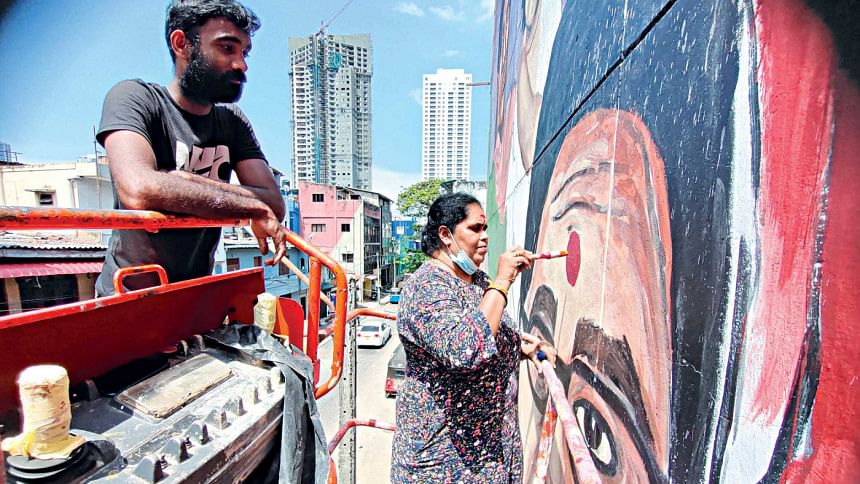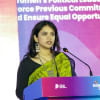The Fearless Collective: Memoir of an artist in Sri Lanka amidst the economic crisis


A couple of years ago, I was on my phone looking for art residencies where I could learn hands-on how to paint large scale murals. It was a dream for me to create those one day — as I myself was a budding self-taught artist with a penchant for street art. And maybe one day, find Dhaka highlighted with art, colour, and voice amidst the chaos.
I believe in the healing power of beauty and in art. I experienced how making art as a new hobby contributed to my personal growth and have witnessed examples throughout history and modern era how art can improve the lives of communities.
Ever since I got into painting, I was keen about mural arts and street art as a form of public art installation. I have seen around the world and read extensively across different economic contexts how the presence of street art positively impacts the well-being and productivity of a community. For instance, Medellin in Colombia, a town torn apart by the legacy of drug lord Pablo Escobar was decorated by public art to better community reintegration, morale and drawing tourists and business attraction in, and it had worked successfully among many other examples across the globe.
My search led me to the incredible work by The Fearless Collective, a movement of participative story-telling involving large beautiful community murals. The murals were created in conjunction with the marginalised communities that the murals represent, in strong, empowering narratives. Spearheaded by artist Shilo Shiv Suleman, Fearless had visions of expanding their methodology to South Asia. An art residency was to be conducted, and I immediately applied. With my passion and dabbling in murals to represent vulnerable communities, and general interest in street art, I aligned immediately with the Collective.
However, the COVID-19 outbreak started soon after, and despite several bonding moments over Zoom calls, the residency got postponed indefinitely. Two years later, we finally got a call to ask who were still interested, and I found my way to Sri Lanka to join a magical cohort of other strong female artists and trailblazers from India, Pakistan, and Sri Lanka, with me representing Bangladesh.
Even though I have never been to another art residency, I along with the other artists immediately felt this was going to be an extraordinary 10 days. Over the next few days, we began unpacking ourselves, and the histories we separately embodied. For the first three days, the nine women artists from across South Asia shared our personal and political histories, where we came from and the movements we now stand in. We spoke about the fears and the resistance movements in our countries.

What was special was not simply sharing our personal and political vulnerabilities— but in how we lived the shared experience of learning to transmute fear to beauty. Following the workshop, we sat and channelled our findings into creating self-portraits utilising the Fearless 6 step methodology.
This was the first step to taking the methodology to the community; by first integrating with ourselves and with our individual artistic expression.
We proceeded on to the workshop with the two communities we were going to be working with as two separate groups— namely, the Sisterhood Initiative, and the We Are From Here Project, an initiative to put the diverse diaspora community and the unique architectural elements in Slave Island, Colombo, on the non-literal map. As I was working with the We Are From Here Project with a resident artist from the community and a Pakistani artist-activist, we designed our workshop accordingly.
The goal was to reach community members' narratives of empowerment, and integrating that with their sufferings that mattered in the larger scheme and the various stories they gathered. We visited and walked around the community prior to the workshop to get a better feel of their lives. Slave Island was almost like a slum, or treated that way. But it was woven with stories of diaspora coming from various religious backgrounds and experiences from working as remittance workers in the Middle East.
I met a Bangladeshi family there as well. As Leena, the Pakistani artist, and I were outsiders while Vicky, the resident Sri Lankan artist, was from the Slave Island community, we aimed to integrate our outsider and insider's views. We formulated the questions — what have we lost, and what have we found?

The next morning, we set up our ritual space, a beautifully decorate physical space ripened for the act of unfurling and healing wholly. We designed our ritual with soil from Slave Island as a grounding element which connected everyone. The community members, one by one, grabbed a fistful of soil and shared what they had lost. Many of them were remittance workers who had lost family members, or carried the financial burden of learning to fend for themselves and their families, even husbands.
Ritual spaces offer magic and beauty that create comfort and flow. They spoke of their grief, the people and homes they have lost holding on to the soil from the space that grounded them. They internalised that through the ritual. As Slave Island was rapidly changing and getting gentrified, many of them risked losing the spaces they came to call home and the community they built. When asked what they have found, they all spoke of building their own financial independence and finding one another in the community.
The ritual was closed as each looked into a mirror, and affirmed "I have found strength in myself and in the community" and ritually anointed themselves by refreshing themselves in rose water as a healing entity. They were rewriting their narratives of hardship into strength.

We shared together, wept together and put together an image portraying their faces and elements that rebuilt their lives.
The image was designed so that while it recognised the struggles the women faced, the narrative was strong with the stories of their strength. Many of them had used their sewing or cooking skills to earn their way out of bankruptcy among other life crises.
The next few days were spent in countless hours of painting. Bear in mind, Sri Lanka was now at the peak of its economic crisis. The entire island was swept with deep economic problems, fuel and power shortages among other things, while heavy protests were going on all over Colombo as well as other major cities. We painted almost continuously through it all, including rain and one day, there was a nation-wide state of emergency declared.
This was the first time most of us painted a mural of this scale. Cranes and scaffolding were used for the first time. The mural stands tall today at the 30 ft x 40 ft back of Rio Cinema Hall in Colombo, Sri Lanka. The four artists worked hard and through rain, protests and power cuts to make it happen, including Shilo Shiv Suleyman, our mentor, who guided us through the uniqueness of painting on such a large scale.

In the end, the mural was completed, not just by the artists, but by the entire community. Everyone participated in the painting process together. Children went up ladders and chairs to put in their mark, while their mothers helped out up the crane or on the ground, some while fasting for Ramadan, to erect the mural that now stands as a monument in celebration of the tenacity and resilience of the Slave Island women. They had participated in rewriting their narrative as well as the construction of the monumental mural that would stand rain and weathering for years to come, at a time when the nation was torn apart by crisis.
The success of actually being able to erect this mural as a self-taught mural artist really intensified the hunger in me to see more street art in Dhaka. I saw the joy and power it immediately brought into the community, and I'm eager to share it in Dhaka and beyond. I am optimistically seeing mural arts being more appreciated in Bangladesh, especially in the restaurant industry, but I hope to see the City Corporation and other government bodies utilising art-form and deshi artists to inspire morale and good civic sense. I also urge cultural organisations and donors to accept applications put forward by fervent young Bangladeshi artists to increase street art in Dhaka.
Isn't it time we find new ways to add colour to our city? Don't our people deserve beauty, smiles and a little morale boost or a place to take a picture because they are proud of the art in their city. Let's make that happen collectively.
Photo: The Fearless Collective

 For all latest news, follow The Daily Star's Google News channel.
For all latest news, follow The Daily Star's Google News channel. 



Comments